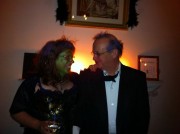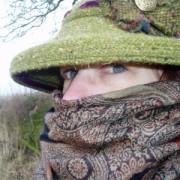A Purple Crayon
She’s six years old, doesn’t speak English, and is a primary witness against her father.
Her mother helps her find what she’s looking for in a tub of blunt crayons. Without a shared tongue, I’m not so much rejected as invisible. On a practical level, I need to bond with this child so the court system won’t rip her heart out.
But the interpreter hasn’t come, the girl keeps colouring. That’s all I’ve got to work with.
The second time she asks her mother, I understand their word for purple. The third time she says it, I hand the purple crayon to her. Everything changes, the door opens and I walk in as an old friend. Until that purple crayon, the little girl lived in a world where few people heard her.
When I was about her age, I had other things on my mind. It pissed me off that people had private thoughts and I couldn’t access them. While little-girl-me didn’t put our family dachshund on the couch and ask in a breathy voice, ‘How does that make you feel?’, I eventually became a trauma therapist.
Trauma does a lot of things to a person, aided and abetted by the traumatic memory being stored outside the brain’s language centre.
In response, trauma clients often generate powerful metaphors, symbols that escape the limitation of words. These metaphors open me, as the listener, to the emotional connectedness of the human experience. And isn’t that the very thing writers search for?
I don’t know if it’s my years as a trauma therapist or because I’m a middle child or an immigrant or a woman, but my writing is awash with that connectedness, but as the recipient rather than the person generating connection.
Nearly every fictional room I construct is filled with a cast of not-me’s enacting someone else’s story. My personal experiences are there, because we never escape our own truth totally, but unobtrusively there, off to one side, perhaps on a top bookshelf or in the pattern of the yellow purple wallpaper.
There’s no reason for this. The times I’ve slashed my own crayon across the greybrown wall of my life, people have been marvellous, as people generally are when we try. Whatever the initial cause, it’s extremely difficult for me to write about my personal experiences. To create this blog, for instance, I’ve spent two weeks unwittingly digressing then deleting, then starting all over again with someone else’s story after all.
I have an instinct for making myself invisible, even to myself – when I actively look for my story, I can’t see it. I’ve become a negative hallucination, something that is there but the mind chooses not to acknowledge.
I first realised this when I took a documentary film course with Tina Gharavi (I am Nasrine). Tina asked us to list significant life events, with the expectation that the list would generate ideas for our three minute autobiography. Easy enough. We all know our special moments. Except on my list, there were no instances when I was the main character. No first kiss, graduation, wedding day. Instead, my most important memories were when I’d supported someone else.
Tina then wanted to know the theme in our list. My God, I thought as I waited for her to call on me, I’m No One. I have no autobiography. My film will be three minutes of empty space. But another part of my brain said, I am a witness.
I thought (perhaps in a fit of sexism), this is what women do. We witness. I don’t mean that we stand by and wring our hands while something manly happens. I mean that we witness in an active way. We hand over a purple crayon and allow others to be.
I took Witness as my theme, wrapped around the story of how I supported my sister through her husband’s death. When recruiting women to participate in the film, I shared my definition of witnessing with each of them. In turn, the woman looked away. I’d wait. She’d begin to give witness, exactly as I imagined it. In the final edit, Laura Emerson (Backscratch Theatre) sung my witness, while other women sang, danced, repeated their witness. An autobiography with a cast of twenty.
 I don’t live my life as a shrinking violet, though. I’m just as likely to sing with the music in a lift or dance to the busker in the street, as I am to sit quietly in Durham Cathedral and wonder where a door three stories up would take me. When I needed references from my undergraduate tutors, they remembered me excruciatingly well after 27 years. Yet, I’m such a purloined letter in my own writing that I’ve been stuck for three days inside this very paragraph, unable to conclude anything from what I’ve spent a fortnight trying to say.
I don’t live my life as a shrinking violet, though. I’m just as likely to sing with the music in a lift or dance to the busker in the street, as I am to sit quietly in Durham Cathedral and wonder where a door three stories up would take me. When I needed references from my undergraduate tutors, they remembered me excruciatingly well after 27 years. Yet, I’m such a purloined letter in my own writing that I’ve been stuck for three days inside this very paragraph, unable to conclude anything from what I’ve spent a fortnight trying to say.
So I look for my truth in the purple yellow wallpaper. Where am I hiding in these 900 or so words? Witness, family dog, blah blah blah, purple crayon. There it is. Every version of this essay includes the girl with the purple crayon. My instruction to self: Learn my word for purple, give myself that crayon, become the primary witness, generate my own connectedness.
Thirty years as a trauma therapist, and I’m only now beginning to figure things out.
Category: Contemporary Women Writers
Comments (13)
Trackback URL | Comments RSS Feed
Sites That Link to this Post
- Featuring Women Writers on WWWB 2013 - Women Writers, Women Books | December 31, 2013





I rarely respond to blog postings, except to the replies to my own article on this site. But I am compelled to write to you. This article stuck a chord. Oddly, I tend to analyze things that deeply move me, so here goes.
The purple crayon was for the child not so much a metaphor but rather a connecting point between you two, correct? It opened hidden doors allowing access? You surely make an excellent trauma therapist, as you yourself have the capacity to stand outside your mind and observe things that happen to you – something that trauma patients also do, as I understand.
This article is about you, although you’ve started with someone else 😉 But you do nail it in the end “Learn my word for purple” – so what is your connecting-word? I suppose as women, as you say, we are all witnesses. And as women, we also yearn to connect. But connecting is not easy, especially if its been violated – it comes with immense trust – the door to which will open only with the magic connecting-word.
Anyway, thank you for the article.
Thanks for your thoughtful comment. Yes, the crayon in the original story (which has been changed slightly to protect the child) was a physical object I used to form a bond when there wasn’t a shared language. The child wasn’t guaranteed to respond. This story exemplifies how creative the therapeutic relationship can make both participants. It has to be a ‘mindful’ relationship in order for it to work.
In reference to myself, the word purple means that state of mindfulness about myself rather than a specific word. Writers (& therapists) are great observers of the world at large; this is my request to myself to observe or witness my own story.
Thanks so much for publishing this, it really resonated with me: I also write fiction, always fiction, never my story. I hadn’t thought of the importance of witnessing before, and I think I’ve fallen in love with the term. Thank you.
So many of the women who participated in the Witness film said something similar, have taken that experience to expand their own creative works. The concept resonates, I think, because it’s an act that binds us into communities and families. When you write, ‘I think I’ve fallen in love with the term,’ I think, ‘Yes.’ Thank you.
Lora,
Wow! What a powerful, illusive yet directly touching post. Thank you so much for sharing such a meaningful story with us. I have been involved with witnessing in art therapy groups and your writing brought me back to thinking about those very moving experiences in group. You have a rare gift.
Art therapy brings up such a rich type of metaphor, doesn’t it? I’m glad you enjoyed the post. Thanks for taking the time to comment.
Lora–
What a beautiful and powerful essay. This line, “I have an instinct for making myself invisible, even to myself – when I actively look for my story, I can’t see it” I’m particularly drawn to. And I like how you came to the conclusion of the purple crayon. I’ll be thinking of this piece for a long time. Thank you for working through it.
Victoria–
I’m so glad you liked it, Victoria. My own purple crayon is exactly the type of metaphor we all generate. The effort comes in recognising them! Thanks for reading.
I read this with chills on my arm. Beautifully written. Powerful stories. And I love the connection to that oh so powerful piece The Yellow Wallpaper by Charlotte Perkins Gilmore in 1892.
“My instruction to self: Learn my word for purple, give myself that crayon, become the primary witness, generate my own connectedness.”
(I’m going to get a sweater, and then a walk, to leave room to reflect on your piece.) – Anora McGaha
Thanks, Anora. Glad you caught the wallpaper reference. Powerful stories – yes, the ones people live are so often the most moving. Glad you enjoyed the piece.
Found myself nodding as I read, catching glimpses of myself in your words. Thank you for the insight. May you always find the purple crayon when you need it.
Thanks for the purple crayon wish, Cheryl! If your glimpses of self are you as witness, then I wish you to be witnessed on occasion as well. A powerful contract, that of witness & witnessed.